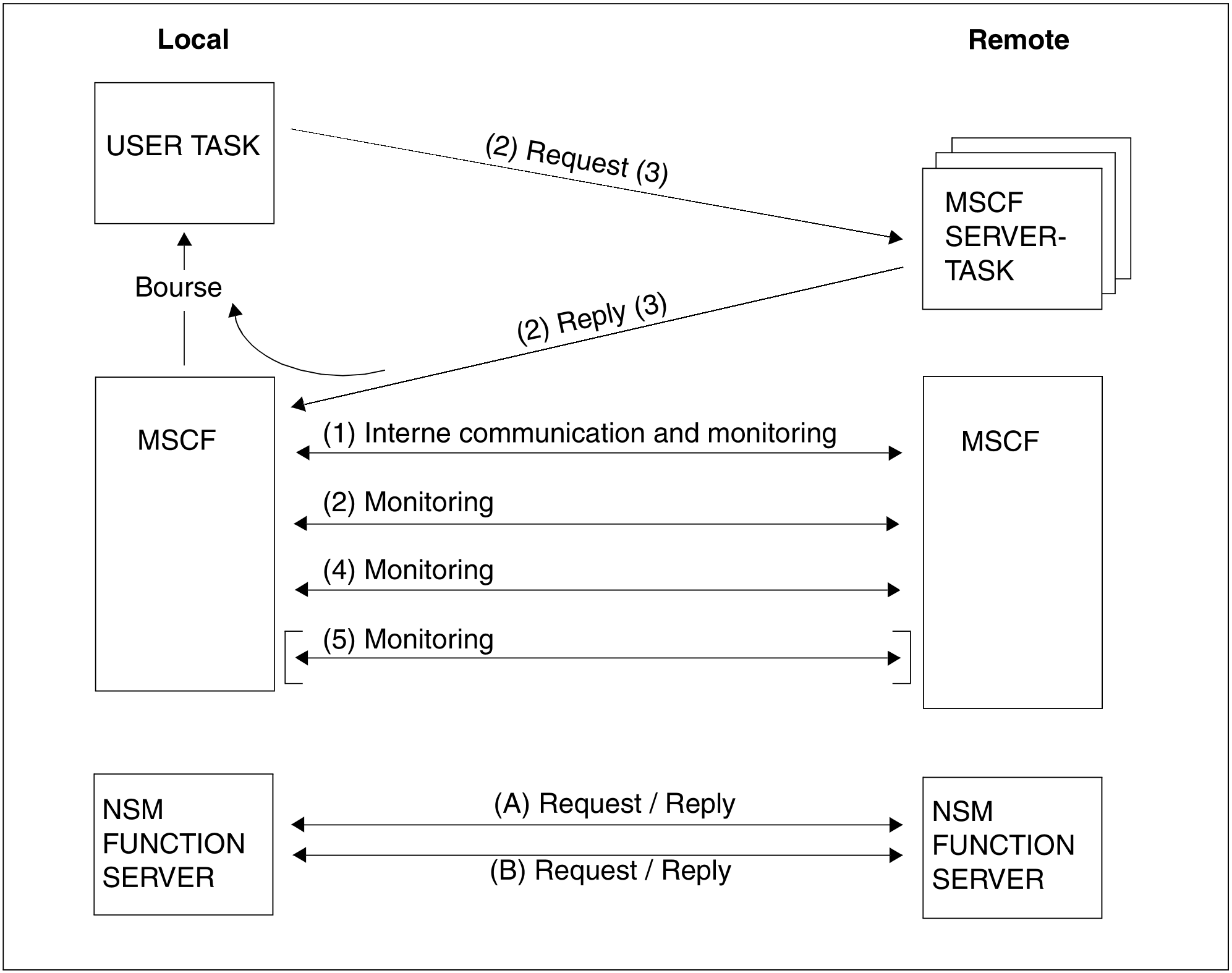The BCAM-based HIPLEX MSCF communication system provides a logical connection between one processor and its partner processors. The communication system processes requests to establish and to clear down connections, monitors the connections and makes mechanisms for the communication between the processors available to the "registered functions" of the operating system.
In HIPLEX MSCF, a distinction is made between a "short connection" and a "long connection".
The "short connection" is established and cleared down on command and is equally available to all "registered functions". Job processing can, in a way, be compared with a remote procedure call, i.e. a communication interface receives the requests, transmits them to the required partner processor, has them executed there by means of the MSCF server task (one of the tasks made available by MSCF) and returns the results (via the MSCF task to the request-submitting task). A connection between the request-submitting task and the request-receiving task only exists for the ("short") duration of each individual request. The reading of a file catalog entry, for example, is processed via short connections.
Another HIPLEX MSCF communication variant is the "long connection" with which a dedicated server task/server task communication is implemented for all the processors.
A long connection is established and cleared down by a "registered function" and is only available to it for communication purposes. The long connection thus links the two server tasks of the "registered function" to the processors over a ("long") time. DLM locks that apply to all processors, for example, are managed by long connections.
The communication itself is handled by BCAM. HIPLEX MSCF sets up four BCAM applications for this (six in the XCS network) on each processor. When an MSCF connection is then set up between two processors, BCAM connections are established between these applications.
The short connection between two processors consists of four or five BCAM connections:
a connection between the $MRSAPP applications on both processors
a connection each between the $MRSAPP application of one processor and the $MRSAPPS application of the other processor
a monitoring connection between the $MRSAPP4 applications on both processors. Optionally, a second monitoring connection can be generated between the $MRSAPP5 applications of both processors.
For a long connection, a BCAM connection between applications with the same name is used on both processors (applications: $MCSNSM, $MCSNLX). In other words, there are four or five BCAM connections (six or seven in the XCS network) between the applications:
| local | remote | ||||||
| (1) | $MRSAPP | $MRSAPP | communication | short connection | |||
| (2) | $MRSAPP | $MRSAPPS | |||||
| (3) | $MRSAPPS | $MRSAPP | |||||
| (4) | $MRSAPP4 | $MRSAPP4 | monitoring connection | ||||
| (5)* | $MRSAPP5 | $MRSAPP5 | |||||
| (A) | $MCSNLX | $MCSNLX | long connections (in XCS network only) | ||||
| (B) | $MCSNSM | $MCSNSM |
Figure 3: BCAM connection of a HIPLEX MSCF CCS connection, *optionally two monitoring connections
The communication via a short connection between two processors with HIPLEX MSCF works as follows:
Connection (1) is used for the internal communication between the MSCF components.
Connection (2) is used to transmit the requests (REQUEST messages) of the local processor to the remote processor and to receive the results (REPLY messages) from the remote processor.
Connection (3) is used to receive the requests (REQUEST messages) of the remote processor and to send the results (REPLY messages) of these requests.
Connections (4) and (5) are used solely to monitor the partner processor. Connection (4) is mandatory, connection (5) is optional.
Connections (1) and (2) are additionally used to monitor the MSCF connection and the partner processor’s vital-signs.
For the long connections (A) and (B) set up by NSM, both the entire communication and the monitoring function are implemented via the one associated BCAM connection.
The figure below illustrates the interaction between the various tasks on two XCS processors during the communication and connection monitoring.
The short connection here shows only the request processing by the local to remote processor.
Figure 4: How the HIPLEX MSCF communication works


